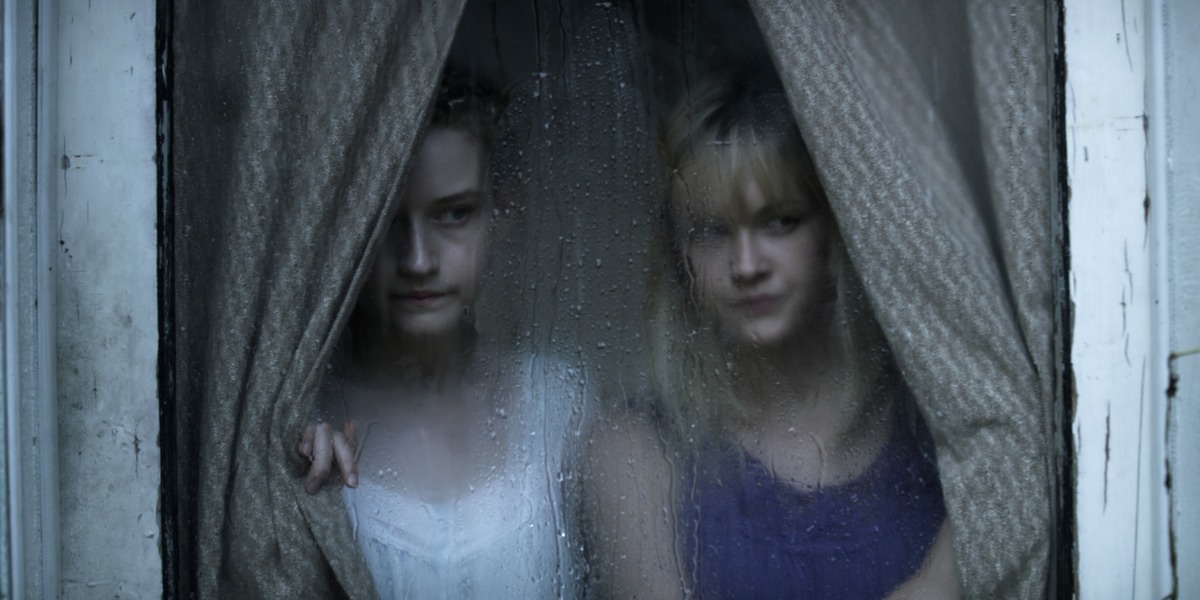By Chlotrudis Independent Film Society
Rating: 5 cats
Director: Jim Mickle
Starring: Ambyr Childers | Bill Sage | Jack Gore | Julia Garner | Kassie DePaiva | Michael Parks

Country: united_states
Year: 2013
Running time: 105
IMDB: http://www.imdb.com/title/tt2309021/combined
Jason says: “WE ARE WHAT WE ARE makes a heck of a case for the much-maligned idea of remaking a foreign film in English. Though the original Mexican version was much-beloved by many (I thought it had a great opening and a slick finale without grabbing me in between), rising star Jim Mickle
has built something even better, something that evolves into one of the most engrossing horror movies of the year.
“There’s a storm hitting upstate New York as the movie starts, and Emma Parker (Kassie DePaiva) heads into town to get some supplies. She’s nervous, twitchy, and ill, falling down dead in the convenience store parking lot. That’s never a good event for a mother of three, but given that her family – father Frank (Bill Sage), daughters Iris (Ambyr Childers) & Rose (Julia Garner), and young son Rory (Jack Gore) – are at the start of a traditional fasting period, with Frank showing many of the same symptoms she is, things get even more tense as Frank declares that Iris, as the woman of the house, will take Emma’s place in the ritual that ends the fast. She wants no part of it, but tradition is tradition.
“Director Jim Mickle and regular co-writer Nick Damici (who also plays the local sheriff) are making their third feature here, and it’s very impressive how they continue to improve even after having started strong with MULBERRY STREET. This is certainly the most polished-looking film they and regular director of photography Ryan Samul have made, but that’s just the start. This group has always had a knack for filling their movies with characters that are just as interesting as their frightening circumstances, and they give themselves quite the challenge by centering the film not on regular people in a horrific situation but the ones who would lurk around the edges of conventional horror films. The brilliance of this one is in how Mickle and company manage to present its main characters as both at once.
“Bill Sage isn’t working to make Frank particularly sympathetic, of course, but he does make the father compelling. He dominates the family even as it’s clear that he’s breaking down physically, displaying the horrible certainty of the true believer even when the strain that the story puts on him. Michael Parks makes an interesting mirror to Sage’s Frank, physically and in temperament, as the local coroner who lacks the internal rot but is hobbled by his own loss. The girls are the ones that make up the story’s center, though, and sometimes in a surprising way. Ambyr Childers plays the one you might
expect to be the center of the story, about eighteen and able to pass between worlds without too much trouble, and she gives Iris a great intensity. It’s Julia Garner, playing fourteen-year-old Rose, who grabs the audience, though, tapping into a character right on the line between a childish moral simplicity and grown-up awareness of exactly what is going on around her, and she makes the movie hers by the time it’s over.
“It’s a heck of a ride to get there; Mickle and company deliver a master class in pumping the tension up with every minute, setting up long-held secrets that give the small movie a grand scope and scale while also showing how tiny things can lead to disaster that makes everything fall apart. He serves as his own editor, cutting between three parallel sequences (with one separated from the others by a long, long time) in a way that reinforces all three without confusion at one point. Things that aren’t always easy to show on screen, like the effect the characters’ fasting has on their judgment and capabilities, come through loud and clear, and the last act is absolutely phenomenal: There’s amazing suspense out of little more than observant characters trying to untangle twisted morality, and a climax that delivers the sort of jolt that could become laughter in less capable
hands.
“Mickle earns those great shocks from how he builds the film on more than just surprise. In writing this movie, he and Damici actually inverted almost everything Jorge Michel Grau did in the original version – rural America instead of Mexico City, father and daughters rather than mother and sons – but in doing so he taps into some pretty powerful themes of religion and tradition. They exert a hold on everyone, sure, but they become toxic when followed too long, and so often they are used by men to make women think themselves inherently sinful. And yet, despite that, they’re often beautiful and reassuring; there’s an amazing sequence where the audience can share the sense of peace that the practitioner of a monstrous ritual must feel. There is
a familiar logic to this movie’s madness that allows it to hit the audience emotionally the way lesser horror flicks don’t.
“A lot of that is because Jim Mickle is really good at what he does, but it certainly doesn’t hurt that he transformed WE ARE WHAT WE ARE into something that may not be uniquely American, but can more easily strike a chord with an American audience. And when you’re looking to make the audience feel something on a visceral level, that’s not a bad thing at all. 5 cats
“Seen 26 September 2013 at Regal Fenway #2 (IFFBoston Preview, digital).”
